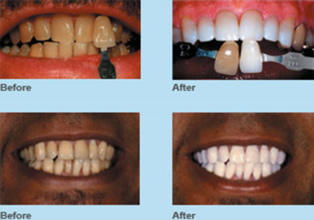Teeth Whitening
At The Gentle Dentists in Shelby Township, one of the most requested cosmetic procedures is teeth whitening. Bleaching has been around in dentistry for the past 25 years. The active ingredients, either carbamide peroxide or hydrogen peroxide, create “scrubbing bubbles” that break down stain molecules in the enamel, resulting in a brighter smile.
Several factors make teeth whitening more effective:
There are a few factors that make teeth whitening more effective:
- Concentration and Availability of Active Peroxide Agents: The stronger the chemical, the more active ingredient is available to create more “scrubbing bubbles.”
- Time to Break Down Stain Molecules: Custom bleaching trays worn at night usually offer the best results.
- Custom Tray Construction: This is important because it is critical that the bleaching material stays in contact with only the enamel of the teeth as long as possible and not covering the gum tissue or even the root of the teeth. If it is haphazardly made and not precisely trimmed, it will cause great tissue irritation, burning the tissue and causing tooth sensitivity. The tray should actually create a seal at the gum line so when gas pressure is emitted from the chemical process, it can actually penetrate into the tooth.
In our opinion, night whitening with precise custom trays works best. Many patients complain that they had Zoom treatments with no long-term results because they were not informed that they had to whiten their teeth at night during sleep to gain a lasting effect. We recommend nightly use of bleaching trays because at night, saliva flow is greatly reduced. Saliva contains enzymes that break down the peroxides, so the reduced saliva helps keep the material in the tray where it is most effectively needed.
The whitening strips do work, but they can’t fit into the nooks and crannies if the teeth are at all crooked. They also only cover the front six teeth, so when one gives a big smile, the back teeth are darker, which doesn’t look so good.
Tooth sensitivity is also a factor when it comes to teeth whitening. There are acidic preservatives added to some of the products used by dentists that make the bleaching material more stable and prevent breakdown before use. The problem is that these agents can make the teeth more sensitive while not being active enough to break down when needed on the teeth. Rather than adding these acidic agents to the bleach, the Kor deep bleaching solution uses refrigeration to keep it active and preserved until needed. Hema, a common dental desensitizer, is used before the bleaching process to reduce any sensitivity. All of these details are needed, as well as a precise fitting tray, to give you the deepest bleaching result possible.
There are many techniques used in whitening teeth, including in-office treatments, whitening strips, paint-on agents, toothpaste, and even floss. This is a huge industry, so when there is money to be made, many gimmicks and strategies are out there. What is important is the fact that your dentist can provide you with the best outcome. Remember that only enamel can be whitened; tooth-colored fillings, crowns, and veneers cannot be bleached. Active decay must be taken care of before bleaching is done to reduce any possibility of root canals. The most important thing is that your dentist evaluates your situation to give you the professional guidance needed for the most predictable results.
Whitening your teeth can significantly improve your smile and boost your confidence. If you have any questions or concerns about the process, our team at The Gentle Dentists is here to help you achieve the best possible results.

Mouth Guard Use
Contact sports require a mouth guard to protect against concussions and tooth injuries. Concussions often occur when the lower jaw slams into the upper jaw. A soft rubber mouth guard with at least 3-4 mm of soft rubber between the back teeth can prevent this injury.
One of our dentists plays hockey and can attest that his mouth guard has saved him numerous times. There are two types of mouth guards:
- Store-Purchased Guards: These work but may not fit well and can hinder speech.
- Custom Guards: Made at the dentist using a custom impression, these provide an accurate fit and better protection. Although more expensive, they offer better comfort and protection.
Comfort is key. If a store-bought guard is uncomfortable, consider a custom-made one. Custom guards provide a better fit, which means better protection and comfort, allowing you to focus on your game without worrying about your teeth.
Wearing a mouth guard is an essential part of playing contact sports safely. At The Gentle Dentists, we can help you find the best mouth guard to ensure your teeth are protected while you enjoy your favorite sports.
Faith and Health
In our practice, we believe that caring for your health is an act of stewardship, as mentioned in 1 Corinthians 6:19-20. Your body is a temple of the Holy Spirit, and maintaining your oral health is a way to honor that. By choosing the right products and being attentive to your oral care, you are fulfilling a God-given responsibility.
Conclusion
If you have any questions about teeth whitening or mouth guard use, please feel free to reach out. At The Gentle Dentists, we are here to provide you with the best care in alignment with both professional standards and Christian values.
Ask The Gentle Dentists, 15055 22 Mile #2, Shelby Twp. MI 48315, call us at (586)247-3500, fax your question to (586) 247-1211, or click the Contact Us button below.
